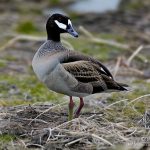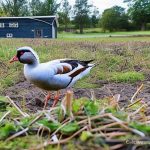Canadian geese overpopulation has become a significant problem in many areas across Canada. These large birds are known for their aggressive behavior and their ability to quickly multiply, leading to an overabundance of geese in certain areas. This overpopulation can cause damage to property, create unsanitary conditions, and pose a threat to public safety. It is crucial to find humane solutions to manage geese presence, as simply removing or harming the geese is not a sustainable or ethical solution.
Key Takeaways
- Canadian geese are attracted to open spaces near water and grassy areas.
- Physical barriers such as fences and netting can be effective in deterring geese.
- Visual deterrents like decoys and reflective tape can also help keep geese away.
- Creating natural habitats like wetlands can redirect geese to more suitable areas.
- Sound deterrents like loud noises or predator calls can scare geese away.
Understanding the Behavior of Canadian Geese
To effectively manage geese presence, it is essential to understand their behavior patterns. Canadian geese are migratory birds that typically mate for life and return to the same nesting grounds each year. They are attracted to areas with open water, ample food sources, and suitable nesting sites. Geese are also social animals and tend to congregate in large groups, which can exacerbate the overpopulation issue.
Implementing Physical Barriers to Deter Geese
One approach to managing geese presence is by implementing physical barriers that deter them from certain areas. These barriers can include fences, netting, or other structures that prevent geese from accessing desired locations such as parks or golf courses. Physical barriers can be effective in keeping geese away, but they may also be costly to install and maintain. Additionally, they may not be aesthetically pleasing or practical in all situations.
Utilizing Visual Deterrents to Keep Geese Away
Visual deterrents can also be used to scare geese away from certain areas. These deterrents can include scarecrows, reflective tape, or predator decoys. The idea is to create an environment that appears unsafe or unfamiliar to the geese, causing them to seek out alternative locations. Visual deterrents can be effective in the short term but may lose their effectiveness over time as the geese become accustomed to them.
Creating Natural Habitats to Redirect Geese
Creating natural habitats that are attractive to geese can help redirect their presence away from areas where they are unwanted. This can involve planting specific vegetation, creating ponds or wetlands, or providing nesting structures. By providing alternative habitats that meet the needs of geese, they may be more likely to choose these areas over places where they are not welcome. However, creating natural habitats can be time-consuming and may require ongoing maintenance.
Implementing Sound Deterrents to Scare Geese

Sound deterrents can be used to scare geese away from certain areas. These deterrents can include devices that emit loud noises or mimic the sounds of predators. The sudden and unexpected sounds can startle the geese and encourage them to leave the area. However, sound deterrents may also disturb nearby residents or wildlife and may not be effective in all situations.
Establishing Rules and Regulations to Manage Geese
Establishing rules and regulations regarding geese management can help control their presence in certain areas. These rules can include restrictions on feeding geese, enforcing leash laws for dogs in areas with high goose populations, or implementing hunting seasons for geese. By implementing these regulations, it becomes clear that human activities are not conducive to the geese’s presence, encouraging them to seek out alternative locations.
Using Repellents to Keep Geese off Beaches
Repellents can be used to keep geese off beaches and other areas where their presence is unwanted. These repellents can include chemical sprays or natural substances that create an unpleasant environment for the geese. While repellents can be effective in deterring geese, they may also have negative effects on other wildlife or the environment if not used responsibly.
Encouraging Responsible Feeding Practices to Reduce Geese Presence
One way to reduce geese presence is by encouraging responsible feeding practices among the community. Feeding geese can lead to an overreliance on human-provided food sources, which can contribute to overpopulation. By educating the public about the negative consequences of feeding geese and promoting responsible feeding practices, such as feeding them natural foods or not feeding them at all, the geese may be less likely to congregate in certain areas.
Collaborating with Wildlife Experts for Long-Term Solutions
Collaborating with wildlife experts is crucial for finding long-term solutions to manage geese presence. These experts can provide valuable insights into the behavior and biology of geese, as well as offer guidance on effective management strategies. By working together, communities can develop comprehensive and sustainable plans that address the root causes of geese overpopulation.
Educating the Community on Coexisting with Canadian Geese
Educating the community on how to coexist with Canadian geese is essential for long-term management. This can involve providing information about geese behavior, explaining the negative consequences of overpopulation, and offering tips on how to discourage geese from congregating in certain areas. By fostering a sense of understanding and empathy towards these birds, communities can work towards finding humane solutions that benefit both humans and geese.
In conclusion, managing Canadian geese overpopulation requires a multi-faceted approach that takes into account their behavior patterns and needs. Physical barriers, visual deterrents, natural habitats, sound deterrents, rules and regulations, repellents, responsible feeding practices, collaboration with wildlife experts, and community education are all potential solutions that can be implemented. It is crucial to find humane solutions that prioritize coexistence rather than harm or removal. By working together and implementing these strategies, communities can effectively manage geese presence while respecting the welfare of these birds.
If you’re interested in learning more about how to keep Canadian geese off of beaches, you might find this article on Poultry Wizard helpful. They have a related article on their website that provides valuable insights and tips on how to care for goslings. Understanding the behavior and needs of these birds can be crucial in finding effective solutions to keep them away from sensitive areas like beaches. Check out the article here for more information.
FAQs
What are Canadian geese?
Canadian geese are a species of waterfowl that are native to North America. They are known for their distinctive black heads and necks, white cheeks, and brown bodies.
Why do Canadian geese go to beaches?
Canadian geese are attracted to beaches because they provide easy access to water and food sources such as grass and insects. They also provide a safe place for geese to rest and raise their young.
What problems do Canadian geese cause on beaches?
Canadian geese can cause a number of problems on beaches, including leaving behind large amounts of droppings that can be unsightly and unsanitary. They can also be aggressive towards humans and other animals, and their presence can disrupt other wildlife.
What are some methods for keeping Canadian geese off of beaches?
There are several methods for keeping Canadian geese off of beaches, including using decoys, installing fencing or netting, using noise deterrents, and using trained dogs to scare the geese away. It is important to note that some methods may be more effective than others depending on the specific situation.
Is it legal to harm or kill Canadian geese?
No, it is not legal to harm or kill Canadian geese without a permit. Canadian geese are protected under the Migratory Bird Treaty Act, which makes it illegal to harm or kill them without a permit from the U.S. Fish and Wildlife Service.
Meet Walter, the feathered-friend fanatic of Florida! Nestled in the sunshine state, Walter struts through life with his feathered companions, clucking his way to happiness. With a coop that’s fancier than a five-star hotel, he’s the Don Juan of the chicken world. When he’s not teaching his hens to do the cha-cha, you’ll find him in a heated debate with his prized rooster, Sir Clucks-a-Lot. Walter’s poultry passion is no yolk; he’s the sunny-side-up guy you never knew you needed in your flock of friends!







